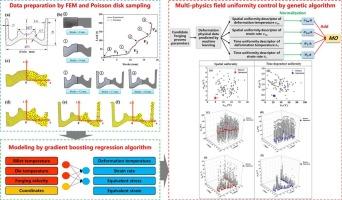复杂零件模锻成形过程全物理场的数字化建模与均匀性控制
IF 6.8
1区 工程技术
Q1 ENGINEERING, MANUFACTURING
引用次数: 0
摘要
高端部件锻造过程中的物理场具有几何形状复杂、多场耦合、非均匀性显著等特点。整个物理场的精确实时仿真是实现智能锻造的一个具有挑战性的瓶颈问题。本文提出了一种将离散提取与整体预测相结合的复杂构件锻造过程全物理场数字建模的通用方法。首先,对锻造过程进行了不同工艺参数(包括摩擦系数、坯料温度、模具温度和锻造速度)下的有限元模拟,构建了建模数据集;该数据集包含锻件在每个锻造阶段100个特征点上的变形物理量(包括变形温度、应变率、等效应力和等效应变)。然后,以锻造工艺参数和特征点坐标为输入,利用梯度增强回归算法建立了各种变形物理量的快速预测模型;模型误差均小于10%,实现了对整个物理场的快速预测,响应时间以秒为单位。最后,采用遗传算法对锻造工艺参数进行优化,以获得更均匀的温度场和应变场,同时考虑锻造过程中不同位置的均匀性(空间均匀性)和锻造过程从开始到结束的均匀性(时间相关均匀性)。在优化工艺下,得到了晶粒尺寸和硬度分布均匀的锻件。该工作可为锻造过程的数字化建模和智能控制提供参考。本文章由计算机程序翻译,如有差异,请以英文原文为准。

Digital modeling and uniformity control of entire physical fields during die forging forming process of complex components
The physical fields during the forging process of high-end components are characterized by complex geometric shapes, multi-field coupling, and significant non-uniformity. Precise real-time simulation of the entire physical field is a challenging bottleneck issue for the realization of intelligent forging. This work proposed a generic method for digital modeling of entire physical fields during the forging process of complex components that combines discrete extraction and overall prediction of field information. First, finite element simulations of the forging process were conducted under varying process parameters (including friction factors, billet temperatures, die temperatures, and forging velocities) to construct a modeling dataset. The dataset contains deformation physical quantities (including deformation temperature, strain rate, equivalent stress and equivalent strain) at 100 feature points on the forging at each forging stage. Then, using the forging process parameters and the coordinates of feature points as inputs, rapid prediction models for various deformation physical quantities were developed using the gradient boosting regression algorithm. The models' errors were all less than 10 %, achieving a rapid prediction of entire physical fields with a response time in seconds. Finally, a genetic algorithm was used to optimize the forging process parameters for more uniform temperature and strain rate fields, synchronously considering both the uniformity at different locations (the spatial uniformity) and the uniformity from the beginning to the end of the forging process (time-dependent uniformity). The forging with uniformly distributed grain size and hardness was obtained under the optimized process. This work could provide insights and research references for the digital modeling and intelligent control of the forging process.
求助全文
通过发布文献求助,成功后即可免费获取论文全文。
去求助
来源期刊

Journal of Manufacturing Processes
ENGINEERING, MANUFACTURING-
CiteScore
10.20
自引率
11.30%
发文量
833
审稿时长
50 days
期刊介绍:
The aim of the Journal of Manufacturing Processes (JMP) is to exchange current and future directions of manufacturing processes research, development and implementation, and to publish archival scholarly literature with a view to advancing state-of-the-art manufacturing processes and encouraging innovation for developing new and efficient processes. The journal will also publish from other research communities for rapid communication of innovative new concepts. Special-topic issues on emerging technologies and invited papers will also be published.
 求助内容:
求助内容: 应助结果提醒方式:
应助结果提醒方式:


